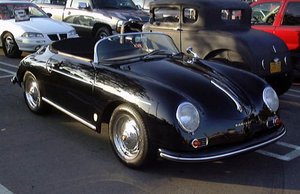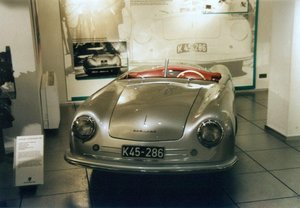Porsche 356
|
|
4-Cam-engine.jpg
356-Carrera.jpg
The Porsche 356 is largely regarded as being the first Porsche automobile, although some argue that the Porsche 64 holds that record. The 356 was created by Ferdinand Ferry Porsche (Ferry being a nickname), with a body designed by Erwin Komenda, and was derived from the Volkswagen Beetle, which Ferdiand Porsche Sr. had previously designed. It was available as both a coupé and a roadster and went through several evolutions before being retired. 356 "SC", "Super 90" and "Speedster" models are among the most desirable versions.
The 356 was introduced in 1948 and was replaced by the 911 in 1963, although they continued to sell 356s in North America through the end of 1965. Leftover 356 engines were used to power Porsche's "entry level" 912 model between 1965 and 1969, and a revised version - with mechanical fuel injection added on - powered the 1976 912E.
In 2004, Sports Car International named the 356C number ten on the list of Top Sports Cars of the 1960s.
Reference
- Wood, J (1997). Porsche: The Legend. Parragon. ISBN 0-75252-072-5.
- The 4 Cam Flat 4 engine - The true Porsche Carrera:
The heart of this special car was a race engine after all, the 547/1 roller bearing Spyder powerplant slightly detuned to 100 real hp from its 1498cc. The Carrera cars appeared together with the beginning of the 356A era - there are some exceptions on PreA cars, four Coupes and fourteen Speedsters have been identified.
The 4 cam engine was designed from the start in a very different manner than the normal pushrod engine. While they both had the same opposed four cylinder layout, the normal engine relied on pushrods to open the valves, the 4 cam used bevel gears and shafts. The plugs were fired from twin ignition coils, and a distributor was placed on the end of each intake camshaft to distribute the ignition spark.
A dry sump lubrication system drew oil from a storage tank into the oil pump, returning it to the engine by means of steel braided lines. Lubrication was critical in the 4 cam, as a roller bearing crankshaft manufactured by Hirth was used.
The Hirth crank moved a high-domed piston inside aluminum cylinders with chrome plated walls. Air cooling was, of course, used to help dissipate heat created in the engine; a large, rounded fan tower that was characteristic of the 4 cam’s appearance housed a fan capable of moving over 1000litres of air per second at high rpm.
The cooling system worked quite well, considering the ignition timing was set at 24 degrees before top dead center. This timing advance was necessary to create more power propelling the lightweight Porsches to performance on par with larger displacement sports cars of the day like Ferrari and Jaguars.
External links
- The 356 Registry (http://www.356registry.org/)
- The Southern California 356 Club (http://www.porsche356club.org/)
- General 356 information (http://vista.pca.org/stl/356.htm)
- 356 Carrera Cabriolet (http://www.356carrera.net/)de:Porsche 356


